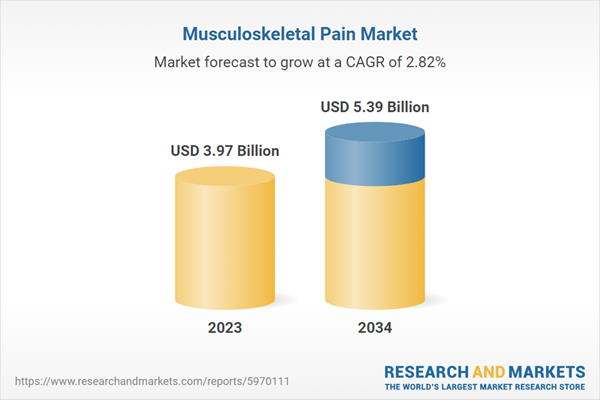The 7 major musculoskeletal pain markets reached a value of US$ 3.97 billion in 2023. The 7MM are forecast to reach US$ 5.39 billion by 2034, exhibiting a growth rate (CAGR) of 2.82% during 2023-2034.
This report provides an exhaustive analysis of the musculoskeletal pain market in the United States, EU5 (Germany, Spain, Italy, France, and United Kingdom) and Japan. This includes treatment practices, in-market, and pipeline drugs, share of individual therapies, market performance across the seven major markets, market performance of key companies and their drugs, etc.
The report also provides the current and future patient pool across the seven major markets. According to the report the United States has the largest patient pool for musculoskeletal pain and also represents the largest market for its treatment. Furthermore, the current treatment practice/algorithm, market drivers, challenges, opportunities, reimbursement scenario and unmet medical needs, etc. have also been provided in the report.
Time Period of the Study
- Base Year: 2023
- Historical Period: 2018-2023
- Market Forecast: 2024-2034
The rising cases of acute injuries, such as sprains and fractures, which can lead to localized pain in the affected muscles, ligaments, tendons, bones, etc., are primarily driving the musculoskeletal pain market. In addition to this, the increasing incidences of several associated risk factors, including obesity, genetic predisposition, sedentary lifestyle, excessive physical activity, muscular imbalance, poor posture, etc., are further augmenting the market growth. Moreover, the emerging popularity of effective medications, such as nonsteroidal anti-inflammatory drugs, muscle relaxants, pain relievers, etc., to relieve disease symptoms is also creating a positive outlook for the market.
Apart from this, the widespread adoption of massage therapy, which helps to relax muscles, improve blood circulation, reduce muscle tension, and alleviate pain, is further bolstering the market growth. Additionally, the escalating utilization of cognitive-behavioral therapy to treat the condition, since it can identify and modify negative thought patterns and behaviors, is acting as another significant growth-inducing factor. Besides this, the rising demand for mindfulness-based stress reduction techniques that can promote relaxation and enhance overall well-being among patients is expected to drive the musculoskeletal pain market in the coming years.
Countries Covered:
- United States
- Germany
- France
- United Kingdom
- Italy
- Spain
- Japan
Analysis Covered Across Each Country:
- Historical, current, and future epidemiology scenario
- Historical, current, and future performance of the musculoskeletal pain market
- Historical, current, and future performance of various therapeutic categories in the market
- Sales of various drugs across the musculoskeletal pain market
This report also provides a detailed analysis of the current musculoskeletal pain marketed drugs and late-stage pipeline drugs:
- Drug Overview
- Mechanism of Action
- Regulatory Status
- Clinical Trial Results
- Drug Uptake and Market Performance
Key Questions Answered in this Report:
Market Insights
- How has the musculoskeletal pain market performed so far and how will it perform in the coming years?
- What are the markets shares of various therapeutic segments in 2023 and how are they expected to perform till 2034?
- What was the country-wise size of the musculoskeletal pain market across the seven major markets in 2023 and what will it look like in 2034?
- What is the growth rate of the musculoskeletal pain market across the seven major markets and what will be the expected growth over the next ten years?
- What are the key unmet needs in the market?
Epidemiology Insights
- What is the number of prevalent cases (2018-2034) of musculoskeletal pain across the seven major markets?
- What is the number of prevalent cases (2018-2034) of musculoskeletal pain by age across the seven major markets?
- What is the number of prevalent cases (2018-20343) of musculoskeletal pain by gender across the seven major markets?
- How many patients are diagnosed (2018-2034) with musculoskeletal pain across the seven major markets?
- What is the size of the musculoskeletal pain patient pool (2018-2023) across the seven major markets?
- What would be the forecasted patient pool (2024-2034) across the seven major markets?
- What are the key factors driving the epidemiological trend of musculoskeletal pain?
- What will be the growth rate of patients across the seven major markets?
Musculoskeletal Pain: Current Treatment Scenario, Marketed Drugs and Emerging Therapies
- What are the current marketed drugs and what are their market performance?
- What are the key pipeline drugs and how are they expected to perform in the coming years?
- How safe are the current marketed drugs and what are their efficacies?
- How safe are the late-stage pipeline drugs and what are their efficacies?
- What are the current treatment guidelines for musculoskeletal pain drugs across the seven major markets?
- Who are the key companies in the market and what are their market shares?
- What are the key mergers and acquisitions, licensing activities, collaborations, etc. related to the musculoskeletal pain market?
- What are the key regulatory events related to the musculoskeletal pain market?
- What is the structure of clinical trial landscape by status related to the musculoskeletal pain market?
- What is the structure of clinical trial landscape by phase related to the musculoskeletal pain market?
- What is the structure of clinical trial landscape by route of administration related to the musculoskeletal pain market?
This product will be updated with the latest data at the time of order. Consequently, dispatch time for this product will be 7-10 business days.
Table of Contents
Table Information
| Report Attribute | Details |
|---|---|
| No. of Pages | 134 |
| Published | May 2024 |
| Forecast Period | 2023 - 2034 |
| Estimated Market Value ( USD | $ 3.97 Billion |
| Forecasted Market Value ( USD | $ 5.39 Billion |
| Compound Annual Growth Rate | 2.8% |
| Regions Covered | Global |









